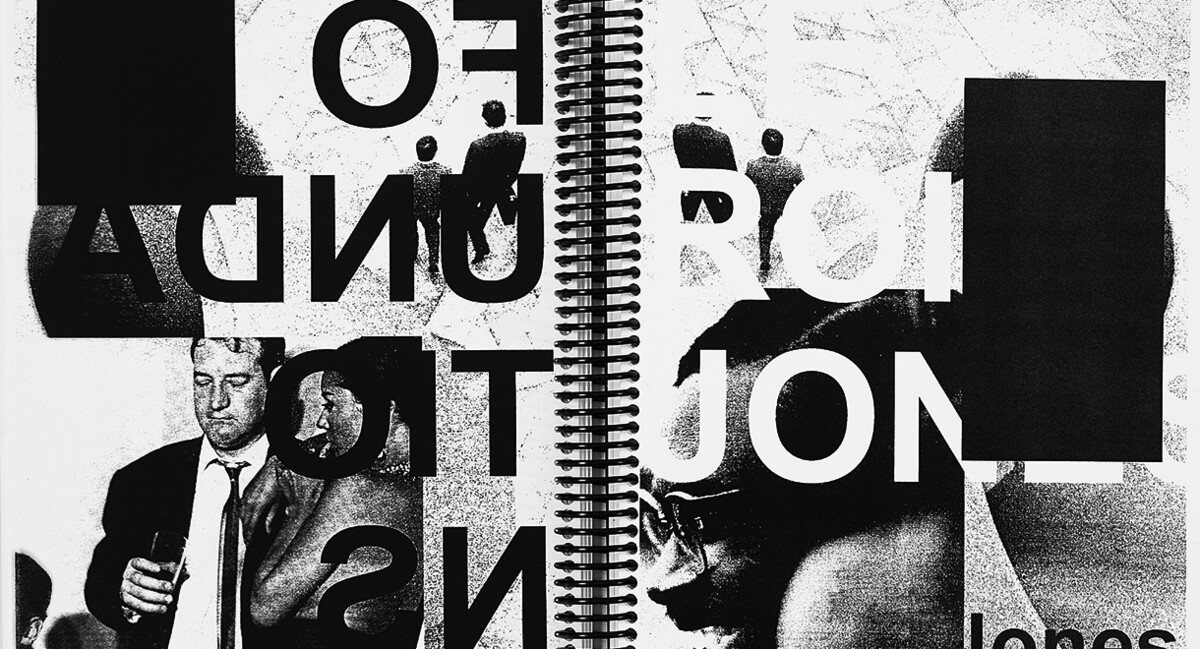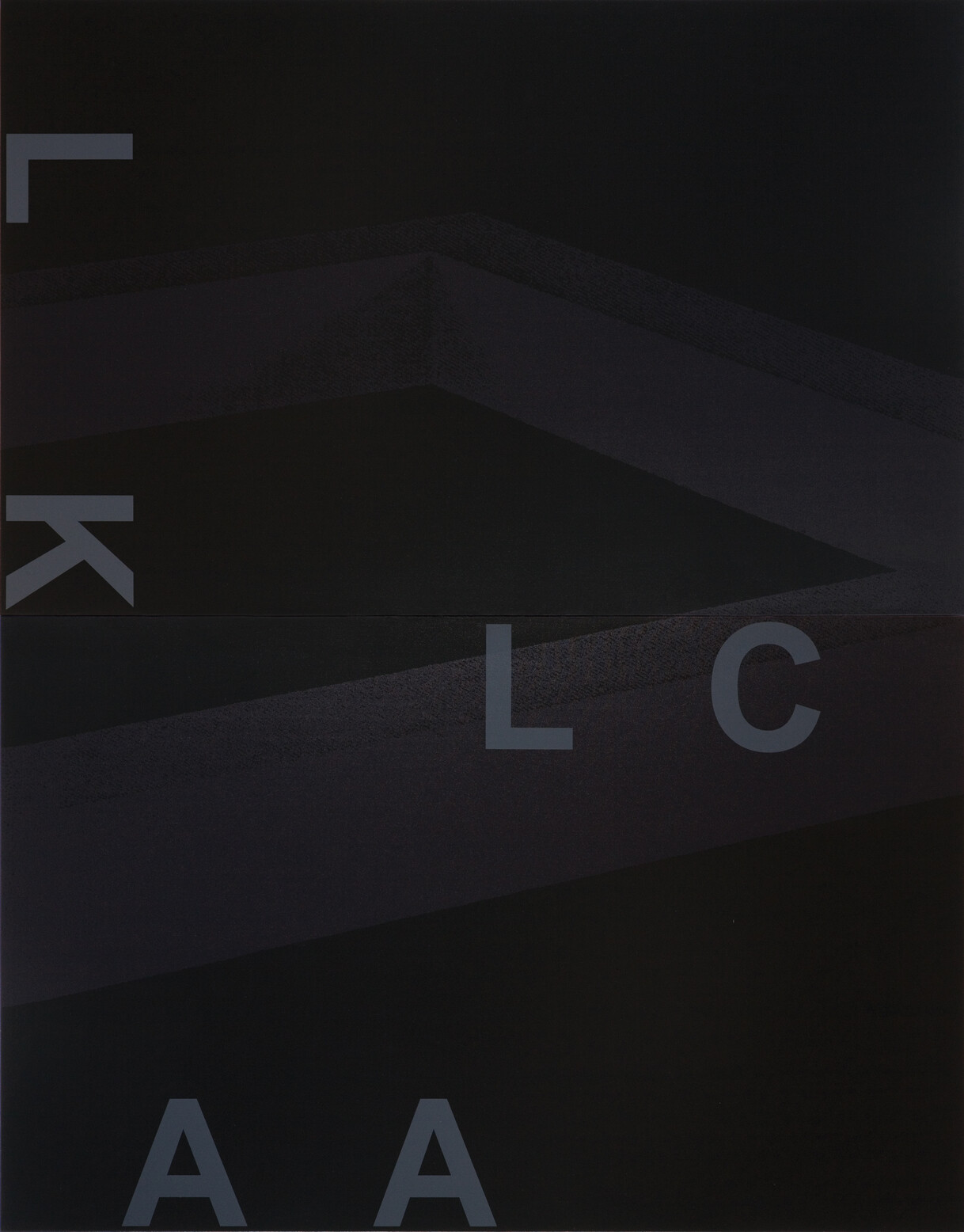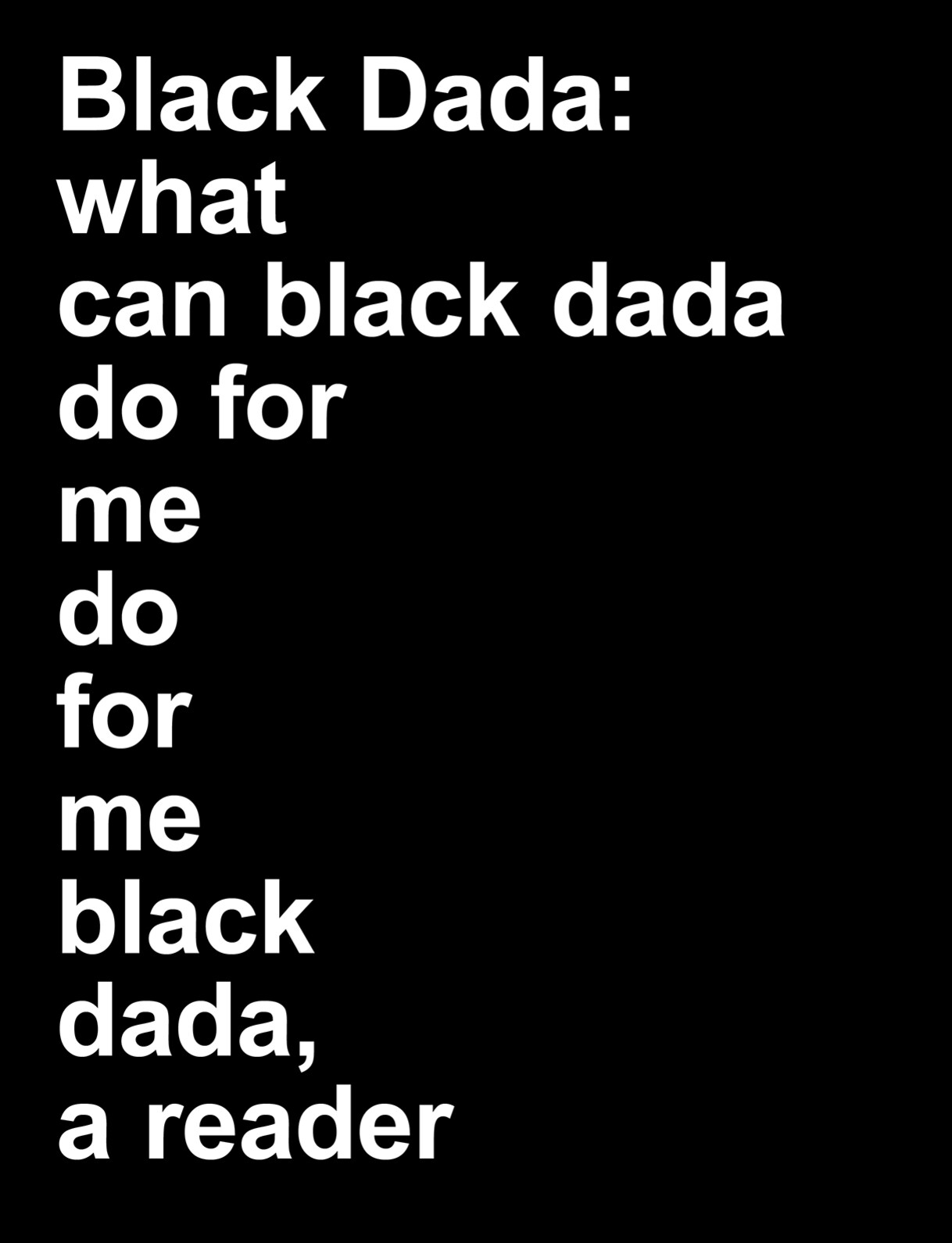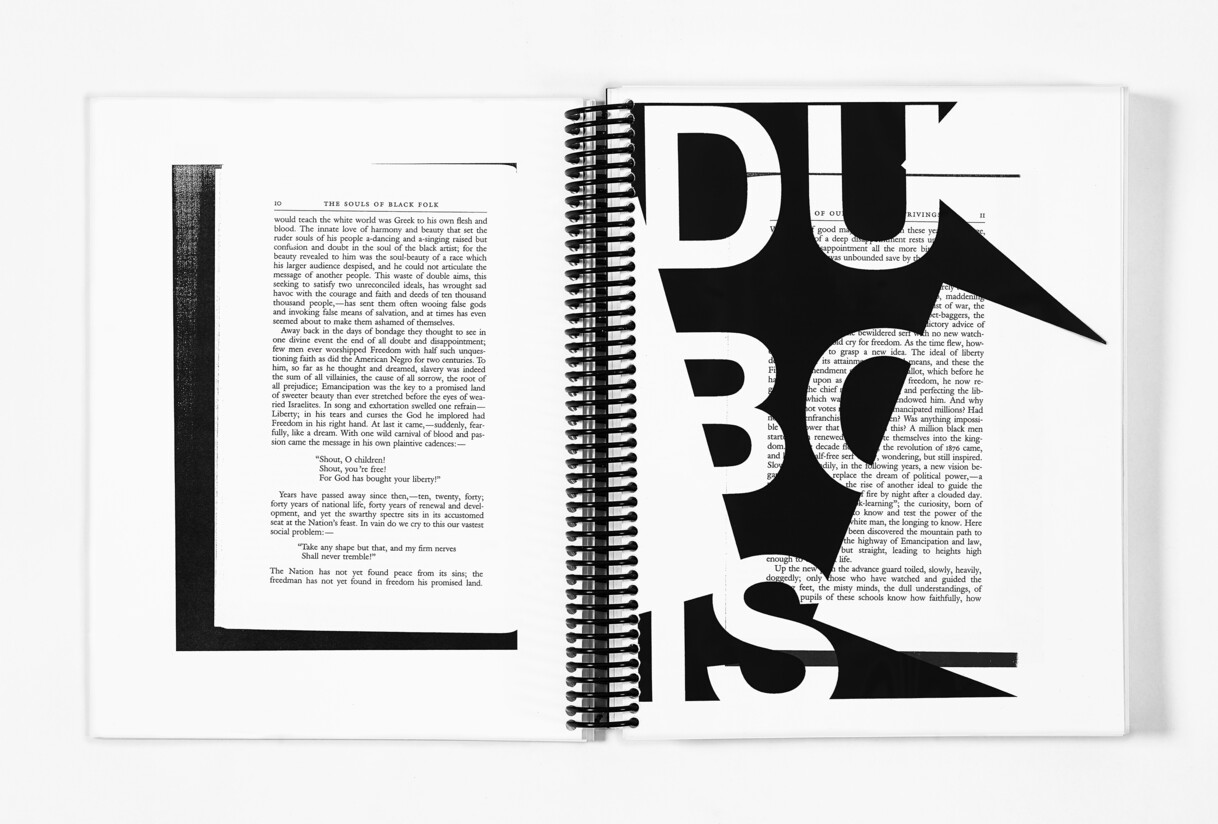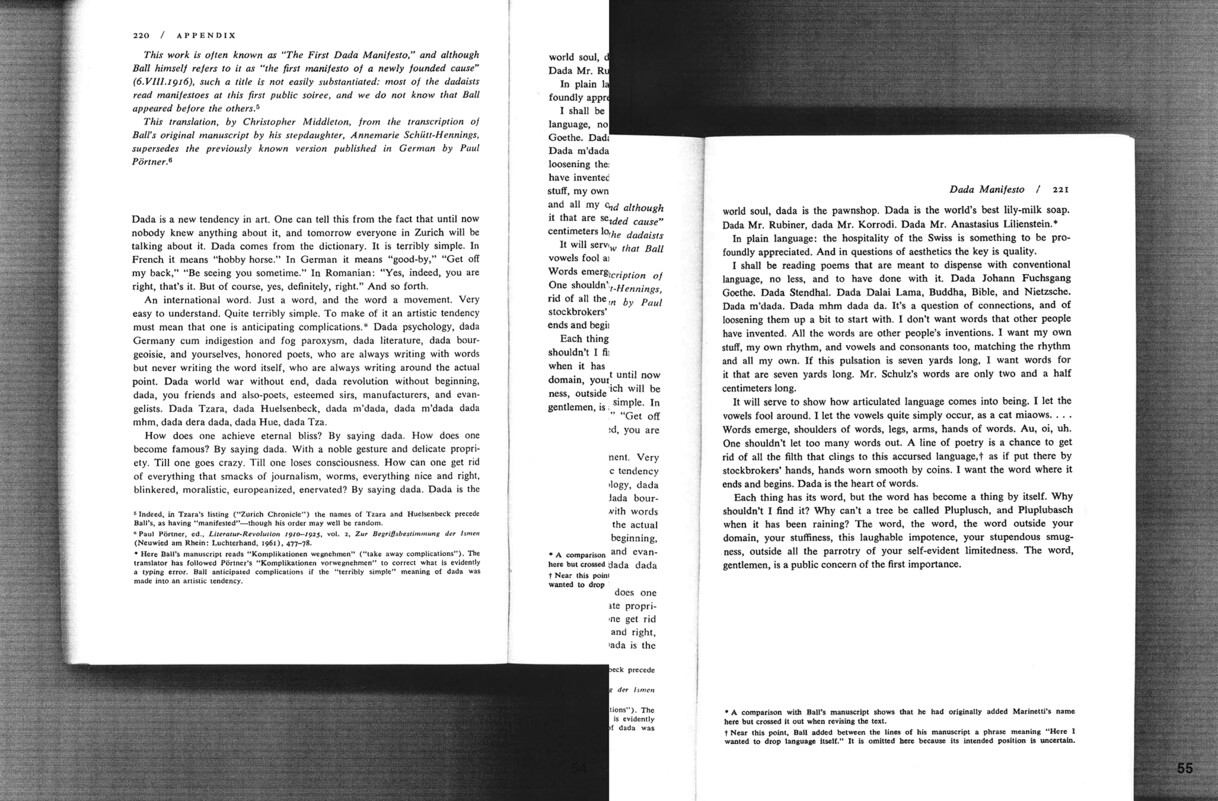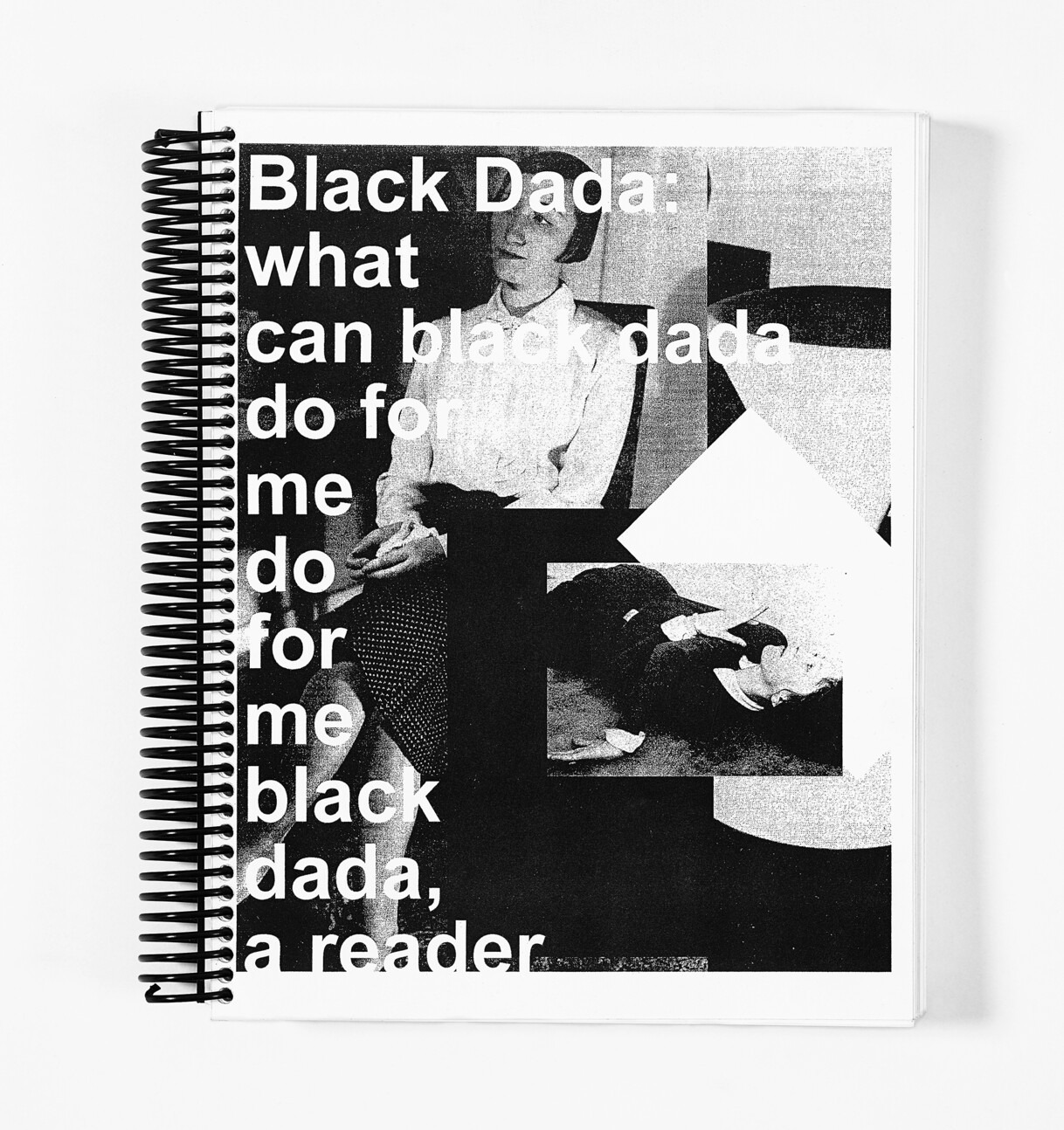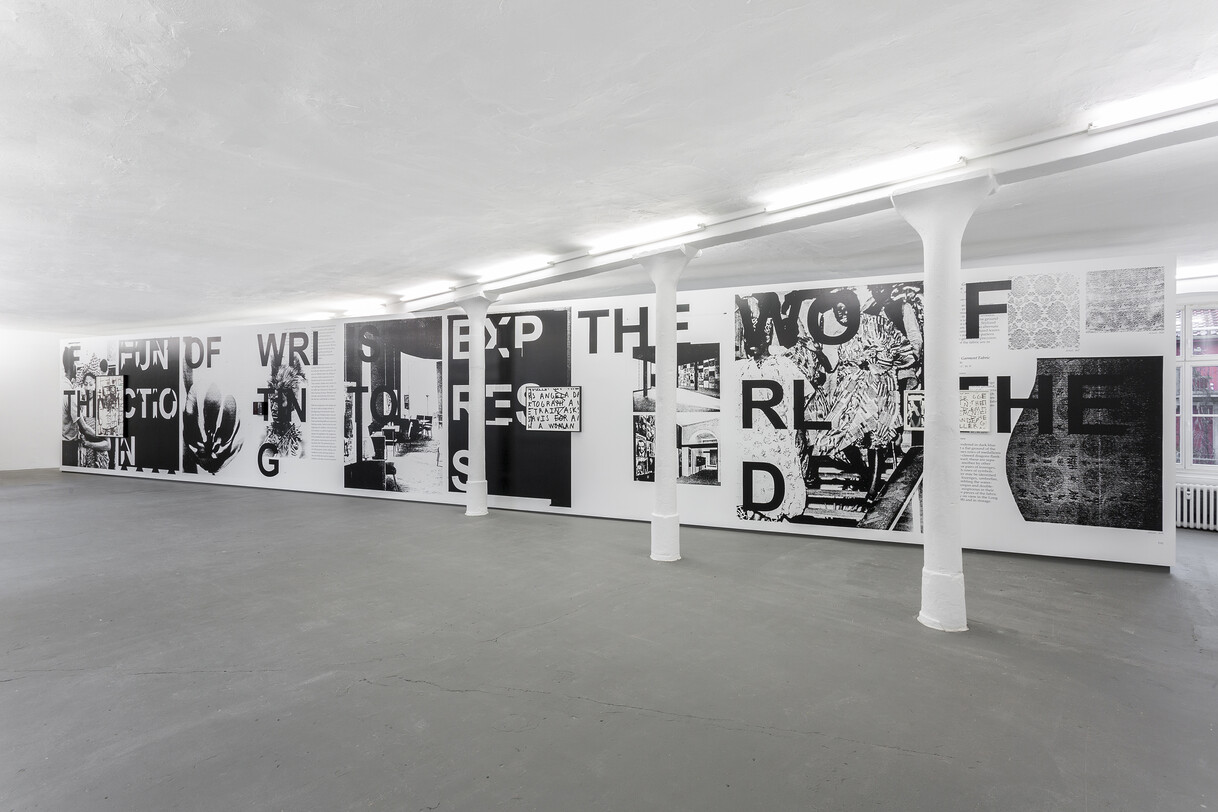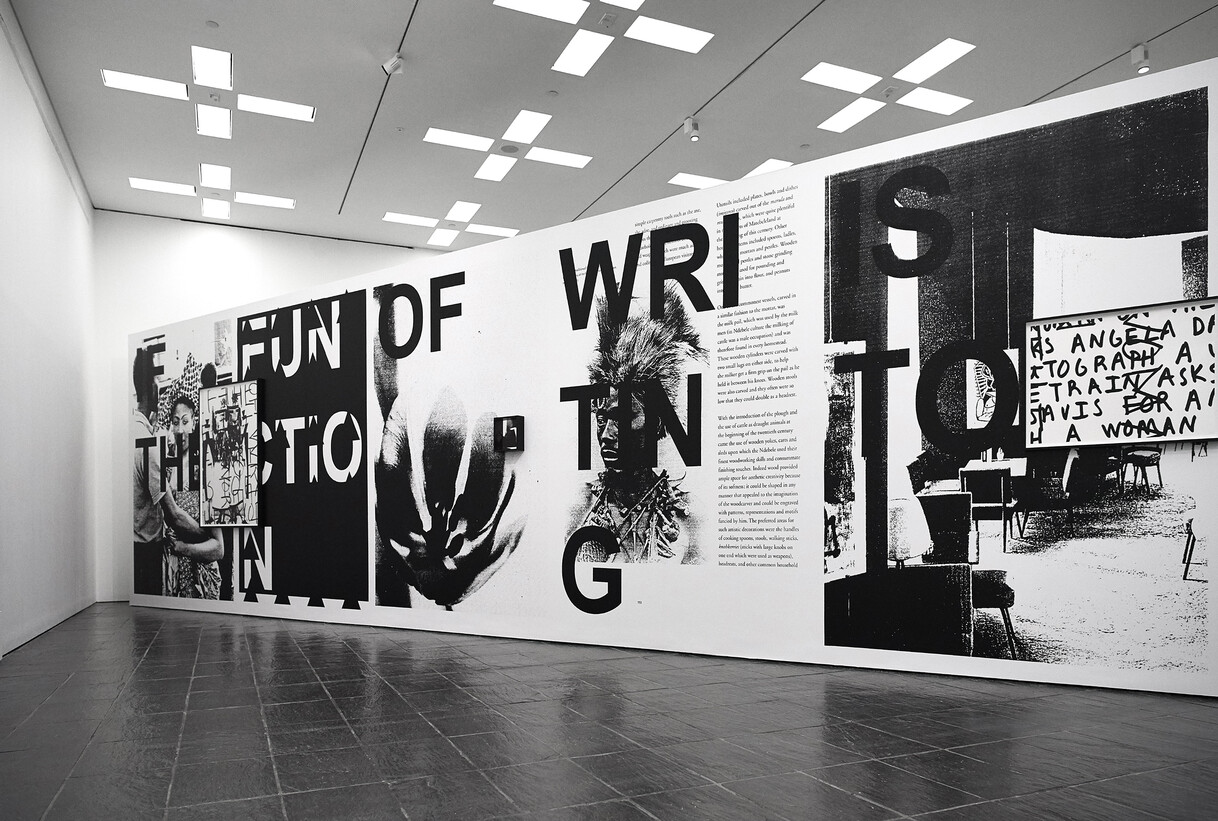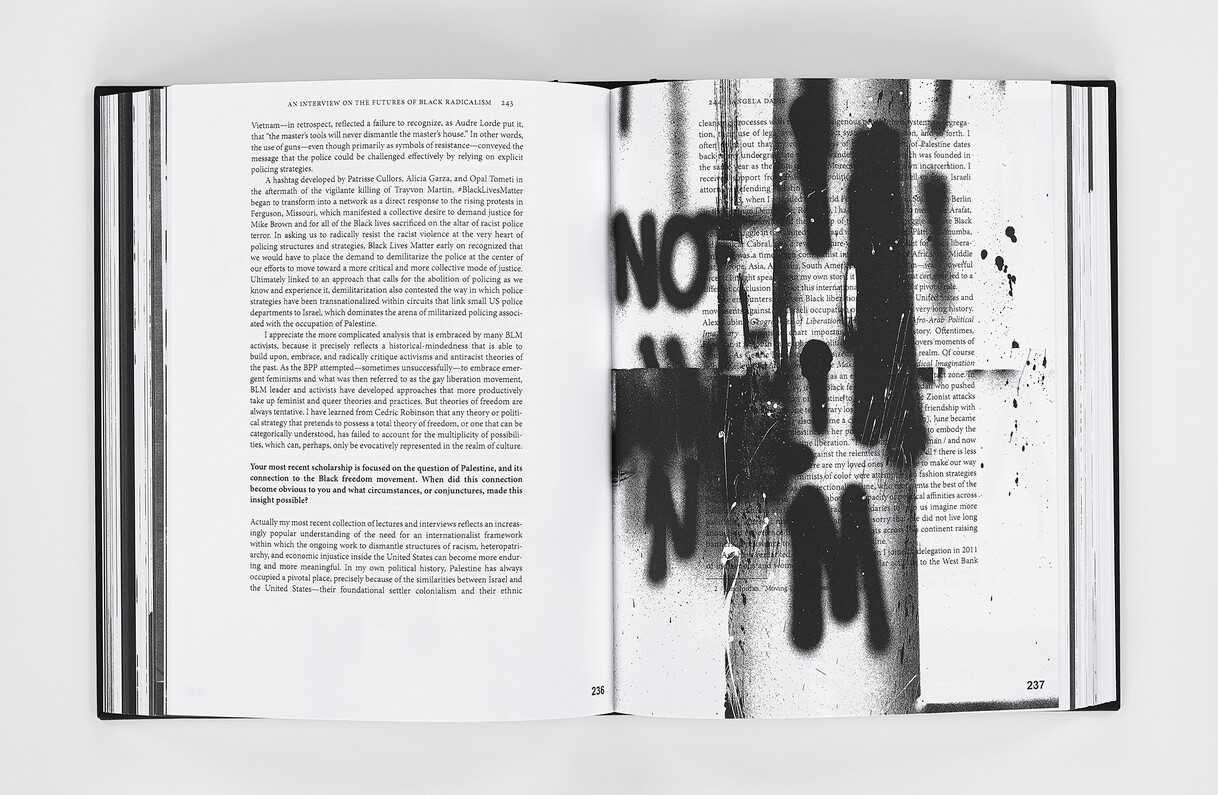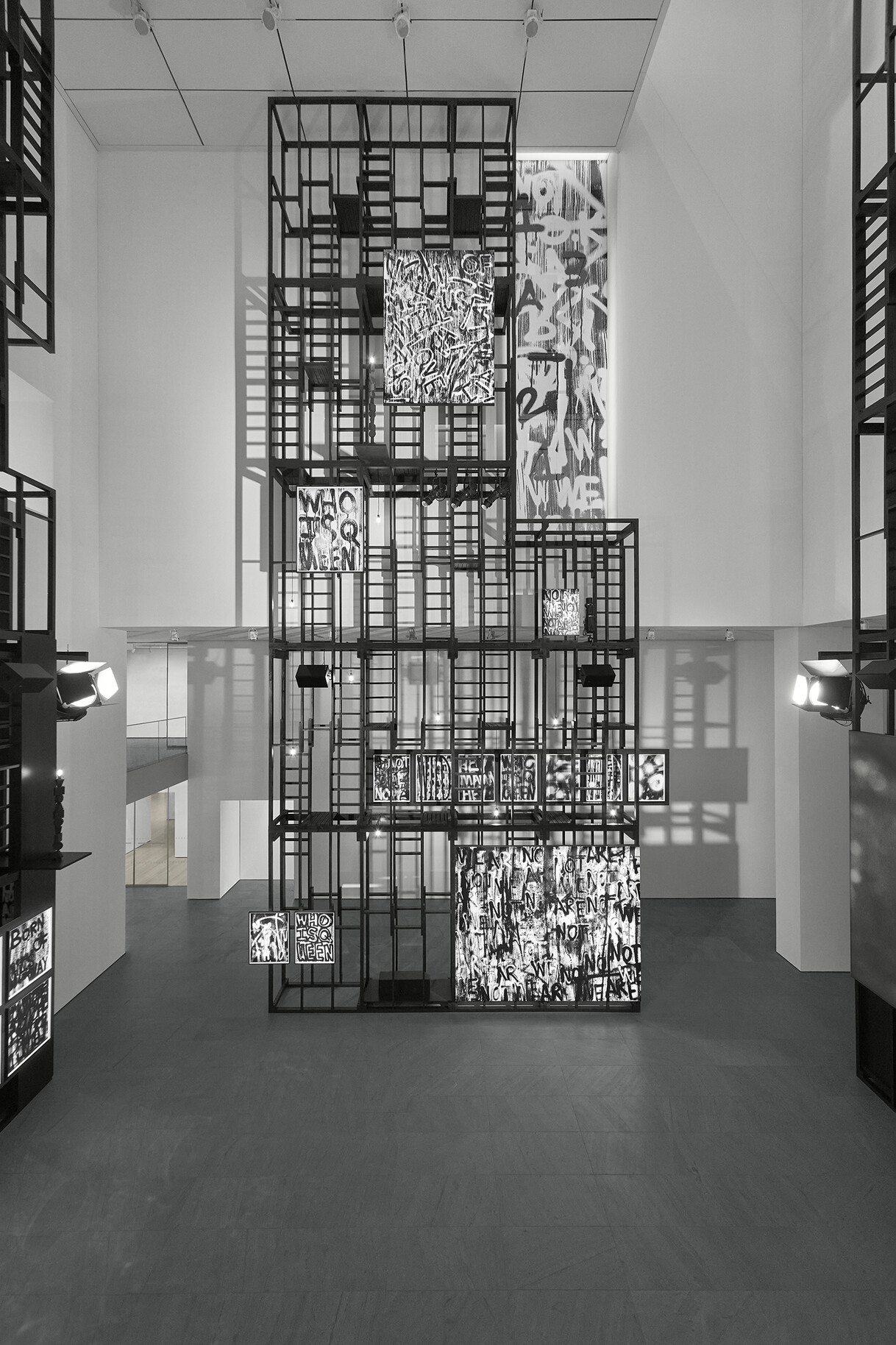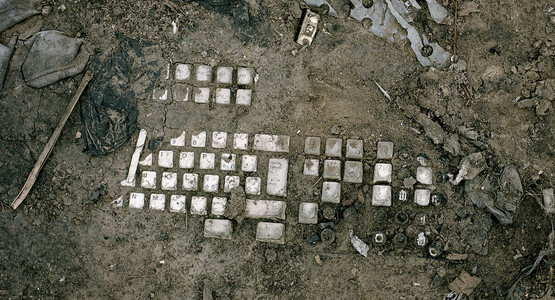From the Harlem Renaissance to Black Dada: Adam Pendleton’s entangled histories
by Kathryn Brown • November 2022
This article explores the political and aesthetic role of Black Dada in the practice of the American artist Adam Pendleton (b.1984). Pendleton’s concept of Black Dada informs his writings as well as his large-scale paintings, collages and installations. It is, he argues, ‘a way to talk about the future while talking about the past’.1 Focusing on the artist’s combinations of word and image in a range of formats, this article will explore how Black Dada problematises histories of conceptual art and connects them to political narratives about race that have unfolded in the United States over the course of the twentieth and twenty-first centuries. It uses the idea of historical ‘entanglement’ proposed by Michael Werner and Bénédicte Zimmermann as a lens through which to analyse Pendleton’s synthesis of multiple literary, philosophical and visual resources in the series of ‘readers’ that he produced between 2011 and 2021.2 The article will further argue that the staging of entanglements between objects, words and ideas under the banner of Black Dada is a way for Pendleton to challenge the physical presence and epistemic power of archives or, as the historian Achille Mbembe puts it, ‘that which life has left behind’.3 By disturbing the order and display of materials that inform the writing of history, Pendleton uses the past to reconfigure the present.
Pendleton began making works under the banner of Black Dada in 2008. In a series of silkscreen-ink on canvas works produced between 2008 and 2018 he repeated, repurposed and fragmented the words ‘Black’ and ‘Dada’, often superimposing single capital letters against abstract geometric backgrounds FIG. 1. These backgrounds are derived from Sol LeWitt’s Incomplete Open Cubes (1974), images of which Pendleton photocopied, enlarged and cropped for the purpose of his own works.4 The deliberate incompleteness of LeWitt’s structures is key to the material and conceptual openness of Pendleton’s aesthetic. In keeping with the metamorphosis of sculptures into grainy, two-dimensional images, the words ‘Black Dada’ (or their constituent linguistic elements) emerge from and disappear into the works’ supports, or compete with a range of incorporated visual material, including printed texts, documentary photographs and drawings. This multimodal approach to image creation aligns closely with the idea of Black Dada, which Pendleton describes as a ‘space to absorb language, to absorb positions, to absorb material, in the broadest sense’.5 Since 2008 language has continued to feature heavily in the artist’s works, which invite appreciation as immersive visual and linguistic environments. These ideas crystallised in a book that the artist created in 2011, titled Black Dada Reader.6 Between 2011 and 2016, the artist produced around twenty, spiral-bound copies of the reader, comprising texts he had selected and photocopied, before a version of it was published in book format in 2017 FIG. 2.
Pendleton is not the first artist to fuse the notion of Dada with ideas about Black identity, history and creative expression. European Dada of the early twentieth century appropriated traditional African arts and invented pseudo-African dialects in its attempt to forge new expressive languages.7 The improvisatory nature of jazz also became, as Rob Wallace puts it, a ‘soundtrack to [the Dadaists’] revolution in language’.8 In an American context, Francis Picabia, who was retrospectively integrated into the narrative of New York Dada, fused abstraction and jazz idioms in his series of Negro Song watercolours (1913; Metropolitan Museum of Art, New York). In contrast to these appropriations of African and African American art for the purpose of fuelling European expressive forms, Pendleton shows how Dada can be used to problematise racialised histories of art and the persistence of social inequalities in the present.
In the opening section of Black Dada Reader, titled ‘Foundations’, Pendleton sets out his indebtedness to the artists and writers of the Harlem Renaissance, to European Dada and to the American poet Amiri Baraka (1934–2014). This includes, in particular, the well-known poem ‘Black Dada Nihilismus’ from 1964, written by the poet when he went by the name of LeRoi Jones FIG. 3.9 If contemporary Black Dada is – as Pendleton suggests – a means of simultaneously talking about past and future, it is important to examine how history is marshalled in this process and to consider its consequences for the present. The way in which Pendleton structures the opening pages of Black Dada Reader creates a trajectory of meaning that refashions history for the purposes of both art-historical and political reflection in the present. The first four essays set the agenda for this and determine the primary conceptual arena for the articulation of Pendleton’s social and political aesthetic. This article posits that the connection forged in these pages between Dada and the foundations of the Harlem Renaissance is fundamental to the idea of Black Dada.
The art and literature that flourished in New York in the 1920s under the banner of the Harlem Renaissance was stimulated by the mass relocation of African Americans from the Southern states in what became known as the Great Migration. Yet this art movement also shared certain social characteristics with Dada: it was informed by the circumstances of the First World War (in particular, the return of Black American soldiers to the United States), was cosmopolitan in nature, expanded into different cities, included contributions by male and female artists and posited social transformation as one of its key objectives.10 It also relied on print culture and the production of works of art that combined word and image in innovative ways to publicise the creativity of Black artists and to combat the persistence of racial injustice in the United States.11 By 1925 the writer and philosopher Alain Locke had declared Harlem to be the site of a ‘momentous folk movement’, a place that would ‘stage the pageant of contemporary Negro Life’.12 Books, magazines and graphic works were central to this cultural self-assertion and articulation of Black identity.
Recalling the importance of this artistic and political period in twentieth-century American history, Pendleton’s Black Dada Reader opens with an essay by W.E.B. Du Bois (1868–1963) FIG. 4 that was included in Locke’s 1925 edition of Survey Graphic. Du Bois was a writer, sociologist and civil rights activist who co-founded the National Association for the Advancement of Colored People (NAACP), edited the association’s magazine, The Crisis, and became one of the leading figures of the Harlem Renaissance.13 Titled ‘Of our spiritual strivings’, the essay was first published as the opening chapter of Du Bois’s book The Souls of Black Folk (1903) and is a powerful statement about the failure of emancipation to create equality of opportunity for African Americans. The essay targets the social, cultural and political marginalisation of Black communities in the United States and examines the challenges of expressing Black identity in a country where the Black population has been perceived as part of a social ‘problem’. In a statement that echoes John Stuart Mill’s conception of political liberalism as a necessary condition for human flourishing, Du Bois argued at the beginning of the twentieth century that every African American has the right ‘to be a co-worker in the kingdom of culture, to escape both death and isolation, to husband and use his best powers and his latent genius’.14 These ideas became motivating factors in the development of the Harlem Renaissance and encouraged the demand for and creation of publishing opportunities by Black writers. By placing this essay among the opening pages of his Reader, Pendleton establishes Du Bois’s text as a key reference point for his own twenty-first-century project.
In keeping with the idea of a reader as an educational object, Pendleton showcases a range of authorial voices and expressive styles in the material he draws together. Du Bois’s essay is followed by Dada Manifesto (1916) by Hugo Ball (1886–1927) FIG. 5, and with this juxtaposition Pendleton encourages his readers to reflect on the relationship between the ideas expressed in these two texts. Stuart Comer has argued that Pendleton uses his Black Dada project to create ‘a theoretical framework that draws together works in various mediums to generate systems of abstraction that resist easy legibility’.15 This is true, but it underestimates the strategic importance that is derived from the structure of the Black Dada Reader. By forging a connection between Du Bois’s text and Ball’s manifesto in the opening pages, Pendleton invites readers to reflect on the theme of liberty that is pursued in complementary ways by these two writers. Ball introduces Dada as a ‘new tendency in art’. Dada, he argues, is an international word, a new way of speaking and therefore, a new way of thinking and conceptualising one’s place in the world. For Ball, this has specific consequences for language: ‘I don’t want words that other people have invented. All the words are other people’s inventions. I want my own stuff, my own rhythm, and vowels and consonants too, matching the rhythm and all my own’.16
Ball’s rhetoric comes close to one of the ideals that motivated the Harlem Renaissance: linguistic freedom. As Locke wrote in his important essay ‘The New Negro’ (1925): ‘The Sociologist, the Philanthropist, the Race-leader are not unaware of the New Negro, but they are at a loss to account for him. He simply cannot be swathed in their formulae’.17 Armed with a new ‘self-respect and self-dependence’ as Locke put it, his contemporary African Americans defied cultural stereotypes and racialised linguistic categorisations. Locke encouraged Black Americans to assert power through identification with linguistic communities of their own creation – a power reflected in expressive languages that ranged from Black folk art to the innovations of a literary and artistic avant-garde.
By placing these two texts together as the opening sections of the Black Dada Reader, Pendleton connects ideas of imaginative and expressive liberty that propelled both European Dada and the Harlem Renaissance. Despite the strength of this conceptual overlap, there are few direct aesthetic connections between the two movements. As Irene Gammel has discussed, the Harlem Renaissance poet Claude McKay was friends with Baroness Elsa von Freytag-Loringhoven and published one of her poems, ‘Dornröschen’ (‘Sleeping Beauty’), in 1922 – although he described her verses as ‘delirious’ and the Baroness herself as a ‘crazy personality’, which are not necessarily bad things in a Dada context.18 Nancy Cunard was another connection between European Dada and the Harlem Renaissance. She was friends with the poet Tristan Tzara, with whom she shared an interest in African art, and in the 1930s she published an anthology of poems, essays and other works by African American writers. Just as Pendleton is keenly attentive to the format of his own reader, Cunard – albeit from a very different perspective – was also clear about her own reasons for creating an anthology:
It was necessary to make this book – and I think in this manner, an Anthology of some 150 voices of both races – for the recording of the struggles and achievement, the persecutions and the revolts against them, of the Negro peoples.19
In her adoption of this format Cunard followed the model of Locke’s New Negro Anthology (1925), a volume that brought together writings and visual materials by poets, playwrights, artists and activists, including Du Bois, who were, or would become, key members of the Harlem Renaissance.20 Indeed, Locke was another figure who in some measure bridged Harlem and European Dada through his own explorations of Modernism’s engagement with African cultural heritage. He repeatedly noted the influence of African art and culture on European modernist artists, but also identified ways in which that heritage could serve as a specific means of empowerment for his African American contemporaries. For Locke, who also collected African art, it was not merely the case that the appreciation of African cultural objects as art would signal that ‘the Negro is not a cultural foundling without an inheritance’, but that it would also serve as a ‘new artistic foundation’ for Black artists in the United States.21
Against this background, how does Pendleton connect these ideas to fashion a contemporary Black Dada? Like the anthologies referenced above, the Reader collects and juxtaposes texts in ways that generate meaning from the connections forged between them. While linguistic freedom is a uniting thread, it is necessary to look more closely at the trajectory of Pendleton’s Reader to see how the past may be marshalled in a way that makes it relevant to the future. The original spiral-bound versions of the volume FIG. 6 had a distinctive physicality in their address to those privileged to have access to them.22 The 2017 book version replicated the visual features of the original, including the imperfections of photocopied pages, uneven margins and fragmented texts FIG. 7. The idea that the work had been mechanically produced from scanned or photocopied texts, including mismatched and uneven pages, is key to both its haptic presence and the relationships that are established between the texts.
By bringing together texts by Du Bois and Ball in the opening pages of his Reader, Pendleton creates an ‘entanglement’ of the kind proposed by Michael Werner and Bénédicte Zimmermann in their conception of history.23 Instead of focusing on the crafting of a linear sequence of events in which objects and people are frozen into particular spatial and temporal places, Werner and Zimmermann envisage history as a process of setting ideas in motion and bringing multiple perspectives to bear on objects and practices. In consequence, history is constituted as a plural field in which no single perspective on objects, people or events remains untouched by others. This is a helpful approach to the ideas that inform Black Dada because it encourages audiences to consider ways in which – in the hands of Pendleton at least – neither texts nor works of art remain intact when brought into one another’s orbit.
The entanglement that Pendleton stages between Dada and the Harlem Renaissance is a model that structures the ensuing pages of the Black Dada Reader. The consequences of this become more forceful in the two texts that follow Du Bois’s essay and Ball’s manifesto. These are Baraka’s poem ‘Black Dada Nihilismus’ and an essay titled ‘The pitfalls of liberalism’ by the civil rights activist and Black nationalist leader Kwame Ture (1941–98; born Stokely Carmichael). These texts develop the first essay pairing and introduce a set of twinned artistic and political issues that warrant further consideration. Baraka’s poem, written in 1964, embraces what is often termed the ‘anti-art’ agenda of Dada and makes it both political and metaphysical. Starting with the expressive use of punctuation typical of Dada – in this case, a full stop placed at the beginning of a sentence – the poem begins after an (unexpressed) ending:
. Against what light
is false what breath
sucked, for deadness.
Murder, the cleansed
purpose, frail, against
God, if they bring him
bleeding, I would not
forgive, or even call him
black dada nihilismus.24
Through its chanted rhythms, the poem conveys a sense of spiritual and political abandonment. There is no comfort from religious belief, no place of safety, no love – just the welling up of ‘a cult of death’. In keeping with Dada’s idea of a release from language, Baraka envisages a sound world that has a specific racial inflection:
Black scream
and chant, scream,
and dull, un
earthly
hollering. Dada, bilious
what ugliness, learned
in the dome, colored holy
shit.25
In Ball’s manifesto FIG. 8, the non-referential language of Dada was envisaged as a kind of cleansing: ‘a chance to get rid of the filth that clings to this accursed language’.26 Devising imaginary African dialects in sound poems was one way in which Dada tried to achieve that aim. As a Black artist writing in 1960s America, Baraka offered a counterpoint to this strategy by probing how poetry can bring about a repositioning of the values that (in Ball’s terms) cling to a conventional and ‘accursed language’. This impacts upon the theme of violence that runs throughout the poem. In part 2 Baraka writes:
Come up, black dada
nihilismus. Rape the white girls. Rape
their fathers. Cut the mothers’ throats.
Black dada nihilismus, choke my friends
in their bedrooms with their drinks spilling
and restless for tilting hips or dark liver
lips sucking splinters from the master’s thigh.27
The violence and, in particular, the sexual violence expressed in this part of the poem has led commentators to debate whether the work is an incitement to aggressive action. The poet Adrienne Rich offers a different reading by identifying this part of the poem as a response to the crime of lynching that extended well into the twentieth century in the United States.28 Tom McDonough draws an interesting parallel with the theme of violence in André Breton’s Surrealist writings, suggesting that Baraka both ‘“surrealizes” African-American revolt and “ethnicizes” European Surrealism’.29
In keeping with the structure of the Black Dada Reader, however, a closer connection can be identified with the ideas expressed by two of European Dada’s protagonists: Tzara and Ball. In the dream-like narratives and experimental writing of his prose work Grains et Issues (Seeds and Husks; 1935) Tzara envisages – and enacts – a release from language. This extends to liberation from thinking in language, but also from morality and linear time. Importantly, this linguistic freedom opens Tzara’s vision onto a moral landscape that exists beyond good and evil. He envisages, for example, a place where:
Dogs stuffed with petrol and set alight will be set on naked women, the most beautiful ones of course. Old men will be squeezed and dried between the pages of immense wooden books and spread out like rugs in bourgeois salons.30
Extending this imagery of physical violence, Tzara describes the writing project of Grains et Issues in terms that anticipate Baraka’s poem:
I would like to write brutally – with a pen driven into the flesh of a world of serpents and of opaque heavy words – stories that will burn the eyes of those who approach too closely this core of misery, stories that are torn up and that tear up that hang in rags on the body of the world from which all light has been banished.31
In this passage and others like it, Tzara contemplates what it means for Dada to write violence and to envision writing itself as an act of violence that enacts social and psychic change.
An important convergence between this aspect of European Dada and Baraka’s ‘Black Dada Nihilismus’ consists in the rhetorical use of violence to prompt a reconceptualisation of value systems. Tzara’s vision was positioned beyond good and evil because it is, in part, a Nietzschean project. When Friedrich Nietzsche called for a critique of moral values in Beyond Good and Evil (1886), it was the value of values themselves that he wanted to call into question. This particular aspect of Nietzsche’s thought appealed to Ball and featured heavily in his early writings. As Philip Mann shows in his analysis of Ball’s projected (but incomplete) doctoral thesis, Nietzsche in Basel, it was precisely the image of the ‘philosopher-artist as a cultural reformer’ that Ball found attractive – an individual who was capable of ‘creating a new society while destroying the old’.32
This raises an important question: how might a society undertake such a reassessment of values in practice? Tzara, Ball and Baraka turned to art – and specifically Dada strategies of language – as a testing ground for questioning the values that they understood to have shaped the societies in which they found themselves. Some of the more extreme aspects of Dada’s social vision (including linguistic experiments that reference violence) are deliberately crafted to test the reader’s response to those values. This is a way of starting beyond the full stop in Baraka’s poem, or of mobilising thought outside a prevailing moral universe in a way that cannot be achieved in practice.
This connects to an idea of freedom that propels Pendleton’s Black Dada Reader. The writer and poet Fred Moten focuses attention on an important facet of Baraka’s ‘Black Dada Nihilismus’ when he asks:
Have you ever suffered from political despair, from despair about the organization of things? What does it mean to suffer from political despair when your identity is bound up with utopian political aspirations and desires? How is identity reconfigured in the absence or betrayal of those aspirations?33
Moten’s questions highlight a problem that is present throughout Dada and the Harlem Renaissance. If both have in common a utopian conception of art and of the kinds of personal liberty that can be instigated by a linguistic revolution, what happens when utopianism is all there is? This is a question that the Harlem Renaissance poet Langston Hughes explored with his typical concision and elegance when he wrote: ‘What happens to a dream deferred?’. Among the possible answers were
Maybe it just sags
like a heavy load.
Or does it explode?34
This problem is addressed in the fourth essay that Pendleton includes in Black Dada Reader. Pendleton places Ture’s essay ‘The pitfalls of liberalism’ (1969) after Baraka’s ‘Black Dada Nihilismus’. In this text Ture debates a specific kind of political violence prevalent in American society of the 1960s: ‘Is it not violent’, he asks, ‘for a child to go to bed hungry in the richest country in the world?’.35 In Black Power: The Politics of Liberation in America (1967) by Ture and Charles V. Hamilton, the notion of political modernisation includes a questioning of the values and institutions of society that is reminiscent of Dada’s injunction to imagine a new social order.36 As previously mentioned, Mill’s political liberalism as a condition for human flourishing can be connected to themes in Du Bois’s ‘Of our spiritual strivings’. For Ture, however, ‘liberalism’ in its American context, associated with laissez-faire capitalism, had signally failed:
The biggest problem with the white liberal in America, and perhaps the liberal around the world, is that his primary task is to stop confrontation, stop conflicts, not to redress grievances. Why? because he enjoys economic stability from the status quo and if he fights for change he is risking his economic stability.37
By placing Ture’s essay after Baraka’s poem, Pendleton juxtaposes the ambition of realising liberal ideals in the absence of challenges to prevailing economic and opportunity structures with the reassessment of values envisaged by Dada and Black Dada. He also offers a rejoinder to readers who might seek to critique Baraka’s rhetorical violence by highlighting the social implications of the everyday violence inherent in racialised American capitalism.
Here Pendleton raises an important point about the role of art and language in debates about sociopolitical change. This leads him to the differences in the reception of Dada and Baraka’s Black Dada, including their respective political projects. Pendleton notes that the references to violence in Baraka’s work have often been interpreted as a literal call to arms. He argues that as a result Baraka’s project is ‘denied the frame of abstraction and of the concept. [...] What of Gertrude Stein or Tristan Tzara would have survived the harsh light of realism, of expression?’.38
By posing this question, Pendleton offers an important reflection on the history of Dada and, more generally, on the canonical European avant-garde. Essentially, he asks: who enjoys the freedom and identity power to create abstract or conceptual art and for it to be appreciated by audiences away from ‘the harsh light of realism’? This recalls a statement about liberty in Du Bois’s ‘Of our spiritual strivings’, namely, the goal of becoming ‘a co-worker’ – one might better say an equal co-worker – ‘in the kingdom of culture’.39 Pendleton’s comment suggests that Baraka was not such an equal co-worker. Rather, he was denied an expressive (and hence political) freedom by having the language of his poem forced into a reductive and realist framework. Pendleton summarises the problem in the following words:
If abstraction remains illegible in the work of the black artist, this is because black individuals remain abstract. […] By reaching past expression, and past the real, to the concept, Baraka was insisting on his right as an artist to be otherwise than black, insisting, that is, on the right to see blackness from all sides at once, or not at all, as it suited him.40
Abstract art has often been associated with personal liberty. This connection is made manifest particularly strongly in the context of Abstract Expressionism and the way that it was harnessed to American ideals of freedom in the context of the Cold War. But Pendleton points to a basic political freedom that underpins both conceptual art and abstraction: namely, the ability to create art beyond the real, to experiment with identity, to enjoy conceptual freedom and to have one’s art appreciated on that basis.
In the hands of Pendleton, Black Dada is – at the very least – a way of staging historical ‘entanglements’ that reinterpret the past for the purpose of imagining a future. As he states, Black Dada and the Black Dada Reader are ‘places to create relationships between different positions (textual, historical, theoretical)’.41 Black Dada, therefore, is not an object or a set of works of art, but rather a tool for reflecting on and ‘relitigating’ assumptions that have driven interpretations of history, identity, politics and creativity.42 In the Black Dada Reader, this is achieved by juxtaposing texts and allowing them to inflect each other’s meaning in ways that unravel established interpretive frameworks.
It is important to note that some of the pages of the Black Dada Reader have also been transformed into large-scale works of art. These take the form of individual canvases and installations that allow the word to dominate physically the exhibition space, thereby recasting conventional reading practices as a whole-body experience. In 2017 an exhibition titled shot him in the face at KW Institute for Contemporary Art, Berlin FIG. 9, and BALTIC Centre for Contemporary Art, Gateshead FIG. 10, showcased Pendleton’s transformation of archival material, texts and images into scaled-up pieces that covered entire walls. Here, as in the Black Dada Reader and its 2021 sequel Pasts, Futures, and Aftermaths: Revising the Black Dada Reader, audiences were required to search for meaning in and among words that were fragmented, crossed-out or smothered by other forms FIG. 11.
In 2021 Pendleton further developed these ideas in an installation at the Museum of Modern Art, New York (MoMA), titled Who Is Queen? FIG. 12 FIG. 13. This exhibition effected a transformation of MoMA’s atrium into a space that was aptly described as a ‘spatial collage’ which, like Black Dada itself, undermined the ‘perceived fixity of cultural and institutional memory’.43 The exhibition was also accompanied by a reader, as opposed to a conventional catalogue, which reflected on and added new textual materials to the unfolding history of Black Dada.44 Here Pendleton created a reformatted, multi-sensory archive from texts and materials held at MoMA and audio files held at the Walker Art Center, Minneapolis.
Who Is Queen? gave a new inflection of meaning to the process of historical entanglement by extending this idea to the space of the museum building itself. In Pasts, Futures, and Aftermaths, Pendleton included Mbembe’s essay ‘The power of the archive and its limits’, in which Mbembe probes the symbolic function of archives and their exertion of authority through material presence.45 ‘The status and power of the archive derive’, he argues, from an ‘entanglement of building and documents’.46 This informational arena is both a ‘quasi-magical’ space for the performance of ritual and a necropolis of documents that are ‘interred’ in it.47 In his creation of an immersive visual, aural and architectural installation for Who Is Queen?, Pendleton gave form to this extended entanglement of history, materials and the built environment. Comer, curator of media and performance at MoMA, explains the institutional implications of this and highlights how the work transformed the museum ‘from a rigid frame designed to regulate official accounts of history into an open, generative and polyphonic device’.48
These transformations have important implications for the role of the audience. Pendleton has spoken of his desire to interrogate ‘the terms under which we engage with information’.49 Similarly, Mbembe argues that archives have no meaning ‘outside the subjective experience of those individuals who, at a given moment, come to use them’.50 Yet – echoing Comer’s point – Mbembe is also sensitive to the role of institutions and the state in determining what documents are preserved, the conditions on which they may be visited and how they are made public. By presenting audiences with an inhabitable yet unstable archive in which images, sounds, words and building materials overlap and disturb each other, Pendleton challenges both the power of the institution and the sense-making strategies of the audience. Giving form to Werner’s and Zimmermann’s idea that the epistemic position of the individual derives from an ‘entangled relation’ between objects, narratives and categories, Pendleton’s newly configured ‘archive’ creates a productive disorientation. As the artist puts it, Who Is Queen? ‘articulates the ways in which we simultaneously possess and are possessed by contradictory ideals and ideas’.51
What are the stakes of staging such entanglements? Extending the intellectual promise of Dada, Pendleton’s Black Dada undoes language and history in order to challenge the epistemic authority of the archive, question histories of the avant-garde and deepen debates regarding racial injustice. Pendleton has stated that Who Is Queen? was ‘undergirded by a kind of Afro-optimism balanced by an abiding Afro-pessimism. […] That is to say, it is not black or white, and locates each within the other’.52 If Black Dada is ‘a way to talk about the future while talking about the past’, then where is the present? This article has argued that it lies in the potentiality created by Pendleton’s entanglements of histories and identities, words and images. Taken together, these create a space that Pendleton describes as an ‘aftermath’ – much like the beginning suggested by the full stop that opens Baraka’s ‘Black Dada Nihilismus’. The act of unsettling the past becomes a means of generating and inhabiting a new temporality. In a typically Dada paradox that simultaneously articulates and negates this ambition, Pendleton concludes: ‘All people are my aftermath anyway there are no words passed passwords passed pass words in the aftermath’.53
Acknowledgments
The author gratefully acknowledges the support of the Center for Advanced Study in the Visual Arts, Washington, and the Terra Foundation of American Art, Chicago, in the research and writing of this article, as well as Adam Pendleton’s studio for their assistance. Finally the author would like to thank Alan Thomas and the anonymous peer reviewer for their invaluable comments on earlier drafts of this article.




